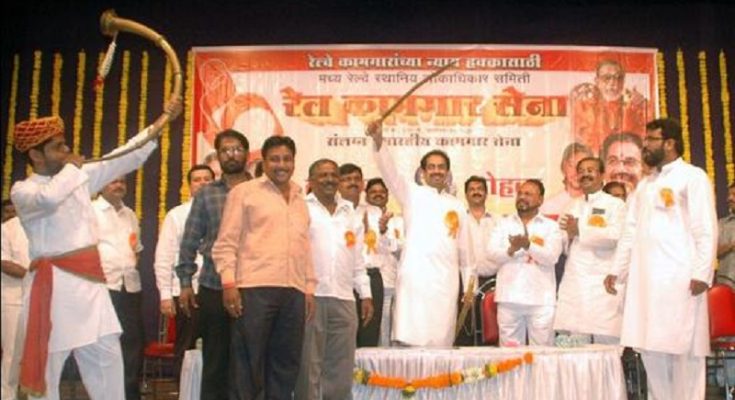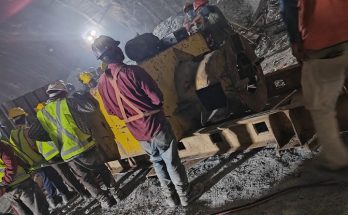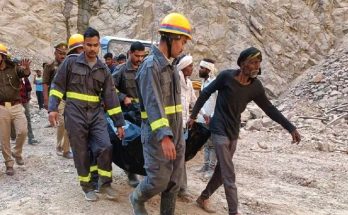Mumbai After engineering the vertical split of Shiv Sena, chief minister Eknath Shinde is now resolute to challenge the Uddhav Thackeray led Sena in the powerful trade union sector.
The Shinde faction has taken on an onerous task as it prepares to launch a parallel version of the Bharatiya Kamgar Sena (BKS), the Shiv Sena’s trade union arm. The BKS provides Shiv Sena its muscle and helps the party garner resources.
In the past, the unions in industry, hospitality, hospitals, banking and insurance sectors provided a formidable base for the party, and ensured its reach among blue collar workers as well as Maharashtrians in white collar jobs.
It’s a tough call to break the network of unions, and indeed previous efforts by rivals to check their dominance in various sectors did not yield desired results. Shinde has now appointed Kiran Pawaskar — a key functionary of the BKS once upon a time — as his points-person.
Mumbai, which progressed from being an industrial city to a financial and services sector hub, has seen a symbiotic relationship between trade unions and political power. In fact, the control over labour unions has been crucial to wielding authority over Mumbai.
It began with the Communists and later socialist leader George Fernandes who ruled the city’s trade unions. Fernandes was known as “bandh samrat” for his ability to bring the city to a halt, thanks to his command over unions in the transport sector and local government. Later, his former lieutenant Sharad Rao carried forward his legacy. They managed to control parts of Mumbai with their undisputed sway over the textile mill workers and those from the engineering sector.
In 1984, Dr Datta Samant, the stormy petrel of union politics, bucked the sympathy wave for the Congress in the wake of the assassination of Prime Minister Indira Gandhi to enter the Lok Sabha from Mumbai. Three candidates of his Kamgar Aghadi were also elected to the Maharashtra assembly from Mumbai in 1985.
The Shiv Sena is reputed to be one of the few socio-political forces with a capacity to shut down Mumbai at will. One of the reasons for this is its presence in the white-collar and blue-collar labour unions in sectors that keep the city running.
In the late 1960s, Shiv Sena entered the trade union sector and over the next two decades, emerged as a major player. Its rise in politics also coincided with the same. From late ‘80s Shiv Sena started ruling the Mumbai civic body which governs the financial capital of India, securing support in Marathi-speaking areas, where a majority of these workers stay.
As a veteran BKS hand noted: “Every trade union is the backbone of its political party.”
Launched in August 1968, the BKS was initially used to dent the influence of the Communists in Mumbai’s labour movement, allegedly at the behest of the Congress. At the time it earned the moniker of ‘Vasant Sena’ — an allusion to the proximity between the party and then chief minister Vasantrao Naik of the Congress.
The BKS has a strong presence in the engineering industries and the hospitality sector in Mumbai, Thane, Konkan, Pune and parts of western Maharashtra like Satara and Ahmednagar. It also has a presence outside Maharashtra in cities such as Indore, Bhopal and Haridwar.
With the Sthaniya Lokadhikar Hakka Samiti (SLHS), the Sena union for white-collared employees, which was also born in 1968, the BKS is credited with boosting the numbers of Marathi-speakers in the formal sector, government and semi-government bodies, banks and financial institutions and also the manufacturing and services sector, creating a constituency for the Shiv Sena.
Now, speculations are rife that Gajanan Kirtikar, Lok Sabha MP and SLHS veteran, may join the Shinde faction.
It is believed that BKS has over 650 units in hospitals, starred hotels and auto majors, of which around 80 per cent are recognised by respective managements. The BKS Mahasangh, an umbrella body of the unions, including BKS, has a membership of over 3 lakh, which includes those across affiliated bodies for municipal workers, the aviation sector, Brihanmumbai Electricity Supply and Transport Undertaking (BEST), Mahanagar Telephone Nigam Limited (MTNL), private power utilities, Railways, mathadi and transport workers.
Similarly, the SLHS, which has been headed by leaders like Sudhir Joshi and now Kirtikar, and is described more as a pressure group than a formal union, has around 150 units largely in banks, insurance companies and airlines, with membership of about 75,000 to a lakh.
“The SLHS played a major role in getting the educated class to join the Sena. Otherwise, the Shiv Sena was seen as an organisation which was involved in street fights,” noted an SLHS veteran. They call themselves silent workers and are known to campaign for the party even in far-off districts during elections, the functionary noted.
Some SLHS men who have risen through the ranks include Kirtikar, who was a Reserve Bank of India (RBI) employee, Arvind Sawant, who was with the Mahanagar Telephone Nigam Limited (MTNL), former Parel MLA Vitthal Chavan and MLC Vilas Potnis.
This explains why Shiv Sena dissidents like Narayan Rane and Raj Thackeray tried to make inroads into the labour union sector in the past.
Rane, who joined the Congress in 2005 after falling out with Uddhav Thackeray, started the Maharashtra Samartha Kamgar Sanghatana (MSKS) to rival the BKS. Raj Thackeray, who launched the Maharashtra Navnirman Sena (MNS) in 2006, also has his Maharashtra Navnirman Kamgar Sena. Both failed to make any headway as the BKS rank-and-file remained steadfast with Thackerays like the larger Shiv Sena due to reasons like ossified structures that ensured unity, a sense of loyalty towards the organisation and the perception that it could give them a better deal.
Now, Shinde, who has walked away with 40 (including himself) of the Sena’s 55 MLAs, to come to power in Maharashtra, is looking to wrest the command of the Sena’s labour unions using dissidents from its fold.
“We are the real Shiv Sena and will work as the BKS,” said Pawaskar, adding that the party would launch a parallel BKS. Pawaskar was the general secretary of the BKS Mahasangh, before he left the party after a fallout with Uddhav Thackeray and joined the Nationalist Congress Party (NCP). He is now in the Shinde camp and has been appointed as the party secretary and spokesperson. Anandrao Adsul, former Lok Sabha MP, who has support among banking and insurance sector workers and Railway staff, has also joined forces with Shinde.
“Shinde saheb will adopt a policy that will seek to give relief to workers at large,” said Pawaskar, while blaming the BKS leadership for letting several industrial majors shut down their units under their watch.
Sachin Ahir, legislator and general secretary, BKS, said Shinde’s attempts to break into their turf would be futile. “The ones who have been vested with this responsibility had tried to diminish the BKS after joining the NCP, but failed,” charged Ahir, without naming Pawaskar. “BKS is the backbone of Shiv Sena… they (Shinde camp) cannot be an alternative to it. It has taken decades to build BKS and its structure. Even if they float a parallel body, it will take years for them to make a dent,” said Ahir.
Arvin Sawant, Shiv Sena Lok Sabha MP from South Mumbai, who heads the BKS Mahasangh and the BKS, said: “Not taking note (of such people) is also a reaction.”
A senior BKS cadre noted that like for Shiv Sena dissidents in the past, infiltrating the labour sector may not be easy for Shinde. For one, Shinde’s claim of being the “real” Shiv Sena is pending judicial scrutiny and for the moment, it seems that he has been able to induce a split only in the legislative and parliamentary parties and not in the party organisation.
“It is the senior leaders who split (from the party) and not small-time workers like us. The common activist has a strong emotional connect with the party and little stake in the larger game of politics. They will always acknowledge that the Marathi manoos has a presence in jobs due to the Shiv Sena. This contribution cannot be overlooked, regardless of the achievements or shortcomings of the party,” explained an SLHS office-bearer, underscoring that the CM’s brave ambition will come to naught.
Mills and boon
The history of labour unionism begins with the textile mills. The textile mills were set up in the middle of the 19th century and towards the end of the century they were staffed largely by workers from the Konkan, especially the undivided Ratnagiri district, and western Maharashtra. They also had a sprinkling of workers from the United Provinces.
Narayan Meghaji Lokhande (1848-1897), an associate of Mahatma Jotiba Phule, is regarded as the father of the labour movement. A former storekeeper in the Mandvi mill, he built a union of mill workers with associates from Phule’s Satyashodhak Samaj. He launched the Bombay Mill Hands Association in 1884.
Lokhande approached the Factory Commission that had been set up in 1884 with demands like a weekly off on Sunday, paid leave if workers were injured on duty and payment of salaries before the 15th of every month.
Many of these suggestions — like a weekly off on Sunday — were incorporated in the Indian Factory Act of 1891.
The textile mill workers gradually emerged as the vanguard of the labour movement. In 1908, they spontaneously struck work for six days after Lokmanya Bal Gangadhar Tilak was sentenced to six years imprisonment at Mandalay, Myanmar.
Later in his life, Tilak gradually began tilting towards the left and the Bolsheviks, who had seized power in Russia. He referred to a class struggle in his speeches to workers.
Led by S A Dange, S S Mirajkar, Gangadhar Chitnis and others, the Communists gradually made inroads into the textile mill workers through their Girni Kamgar Union — the sword arm of the Samyukta Maharashtra movement, which ensured the formation of a Marathi-speaking state of Maharashtra with Mumbai as its capital. They also branched into other industries like those in the manufacturing sector.
Launched in August 1968, the BKS was led by Dattaji Salvi. The SLHS, which caters to white-collar employees, was also launched that year.
Salvi, who was called ‘Commander,’ was known for his aggression and booming voice, and had a background in the Congress party’s INTUC. He was influenced by Marxist theoretician M N Roy.
The BKS helped the Shiv Sena undercut the influence of the Communists in Mumbai’s labour movement, allegedly at the behest of the Congress.
The decade of the 1980s saw the underworld enter the union sector. The ‘Marx to Mafia’ transformation was complete. The emergence of a deracinated group of union leaders who served as interlopers with the management also dealt a blow to the cause, as the workers focussed more on financial demands than a larger ideological motivation.
The textile mills were shut down in the decade of the 1980s as their managements found it more lucrative to sell their lands. Ironically, the Shiv Sena was a silent spectator as around 2.50 lakh mill workers were dispossessed.
One of the reasons for the 1992-93 communal riots in Mumbai was its gradual de-industrialisation. Sociologists like Jan Brennan have detailed how the closure of textile units in Ahmedabad after 1985 affected the social fabric and led to the communalisation of the city.
The labour unions, many of whom are affiliated to political parties, have their own turfs of influence. For instance, the Congress-affiliated Indian National Trade Union Congress (INTUC) and the Communist Party of India’s (CPI) All India Trade Union Congress (AITUC) have a strong presence in the government, semi-government and private sector. The INTUC also has a base in the Maharashtra State Road Transport Corporation (MSRTC) workers. The Communist Party of India’s (Marxist) labour union, the Centre of India Trade Unions (CITU) has a presence in the manufacturing sector, the unorganised sector, sugar industry workers and the ASHA and Anganwadi workers. The socialist Hind Mazdoor Sabha (HMS) has support in the transport sector.
(साभार हिंदुस्तान टाइम्स)
वर्कर्स यूनिटी को सपोर्ट करने के लिए सब्स्क्रिप्शन ज़रूर लें- यहां क्लिक करें
(वर्कर्स यूनिटी के फ़ेसबुक, ट्विटर और यूट्यूब को फॉलो कर सकते हैं। टेलीग्राम चैनल को सब्सक्राइब करने के लिए यहां क्लिक करें। मोबाइल पर सीधे और आसानी से पढ़ने के लिए ऐप डाउनलोड करें।)



